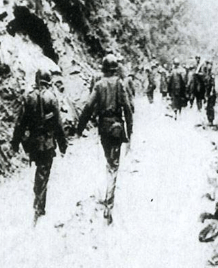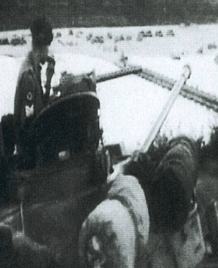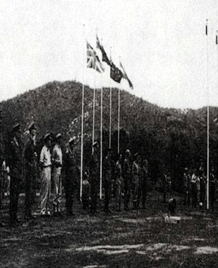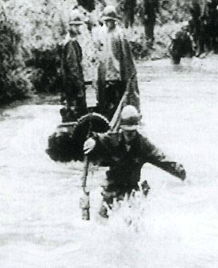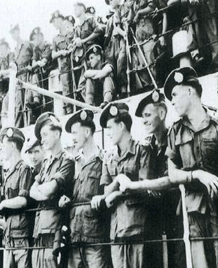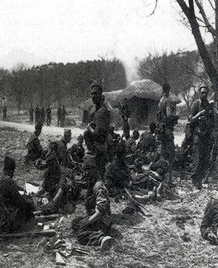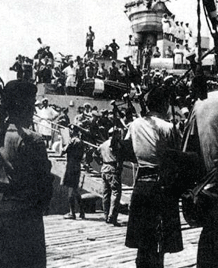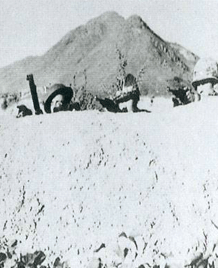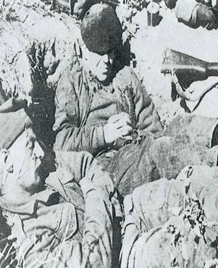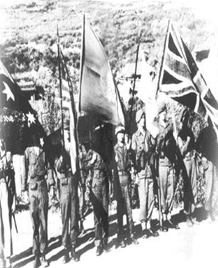 United Kingdom
United Kingdom
List for UN Allies
Background of Participation
With the UN's resolution call for military assistance to Korea, on June 30, 1950, the United Kingdom dispatched one light aircraft carrier, two light cruisers, three destroyers, and three convoys from the Far Eastern Fleet in Hongkong to Japanese territorial sea, and attached them to the US Far Eastern Navy. In addition, on the UN Secretary-Generals request for sending ground forces, the British government decided to dispatch the 29th Infantry Brigade on July 26th.
As the Naktong River defense line was at the risk of collapse, United Kingdom dispatched the 27th Brigade in Hongkong for the Korean War on August 20th. In early September, United Kingdom also dispatched the 41st Marine Commando Unit to the Far Eastern Navy. The 29th Brigade, led by General T. Brodie, arrived in Pusan on November 18th. By dispatching the Army, Navy, and Marine, United Kingdom came to lead, jointly with the USA, the Korean War. It exerted influence on the British Commonwealth members to participate in the Korean War.
Activity of the Ground Forces
The British 27th Brigade was deployed along the Naktong River defense line near Hyonpung by being assigned to the US 1st Cavalry Division on September 4, 1950. As UN forces had launched an all-out offensive along the Naktong defense line on September 16th, the 27th Brigade crossed the Naktong River and attacked the North Korean 10th Division which was defending Hill 282 near Songju on September 21st. After a bloody offensive and defensive battle, however, the Brigade was forced to retreat.The Brigade, after one Australian Battalion had been attached to it, changed its name to the British Commonwealth 27th Brigade. On October 17th, the Brigade occupied Sariwon, and advanced to Bakchon, crossing the Chongchon River on the 23rd. After chasing North Korean forces, the Brigade advanced to Chonju on 30th. With CCF entry into the war, the 27th Brigade began to withdraw. It secured a bridgehead in north of the Chongchon River on November 5th. The British 29th Brigade, which had arrived in Pusan on November 18th, was committed to the operations of covering supply route and cleaning up enemy remnants at Kaesong.As UN forces had been forced to retreat by the Chinese second offensive, the 27th and 29th Brigades retreated to the 38th parallel, covering UN forces?withdrawal. With the Chinese New Year offensive, the 29th Brigade began to retreat on January 3rd, 1951, after covering the withdrawal of the US 1st Corps. While retreating the Brigade was attacked by CCF, losing 300 personnel and a number of equipment including 10 tanks. It became a reserve unit of the US 1st Corps after retreating to Suwon on January 4th. On March 30th, the 29th Brigade was attached to the US 3rd Division. It advanced to the riverside of the Imjin, setting up defense positions. With the start of the Chinese April offensive on April 22nd, the 29th Brigade engaged in a desperate combat with the enemy in the Imjin riverside area. While retreating to Dugjong, it was chased by CCF and suffered a number of casualties. Finally, the Brigade withdrew to Yondeungpo.
From April 23rd to 25th, through a desperate battle, the 27th Brigade defeated Chinese forces which had attempted to advance to Kapyong. The name of this Brigade changed to the British Commonwealth 28th Brigade after the combat.As the Canadian 25th Brigade had arrived in Korea in early May 1951, United Kingdom hurried to integrate British commonwealth forces. As a result, on July 28th, the British Commonwealth 1st Division was established, including the British 29th Brigade, the British Commonwealth 28th Brigade and the Canadian 25th Brigade.
On October 3rd, the 1st Division launched Operation Commando to obtain the Jamestown line, which had been installed 10kms north of the Imjin River. On October 4th, the 25th and 29th Brigades advanced to the Jamestown line. The next day, the 28th Brigade captured Chinese strong defense positions, Mt. Maryang and Hill 217. Thus, the 1st Division successfully completed the operation of advancing to the Jamestown line. In this combat, the Division suffered 58 casualties and 262 wounded.
On November 4th, Chinese forces launched a surprise attack on the 28th Brigade, and recaptured Mt. Koryang and Hill 217. After this battle, a lull situation was maintained in front of the Division.As the lull infighting continued into 1952, the 1st Division concentrated its efforts on capturing enemy prisoners. In the beginning of October, the lull in the front was broken by Chinese offensive initiatives. On October 23rd, CCF attacked the area of the 25th Brigade. The Division repelled Chinese forces, however, by firing 12,000 shells. On October 27th, the 29th Brigade took over Hill Hook. From November 16, Chinese troops attacked the Hill Hook, but retreated leaving behind 100 bodies.
At the end of January 1953, the British Commonwealth 1st Division turned over its operation region to the US 2nd Division. It switched to a reserve unit after 18 months since its establishment. The 1st Division returned to the Jamestown line on April 7th, after training, rest and maintenance. From May, enemy shelling on the front of the Division increased suddenly, and its reconnaissance operations were activated.
As the British 29th Brigade launched a preemptive attack on Hill 157 on May 25th, the CCF attacked the Hill Hook with concentrated shelling on the 28th. Thanks to the Brigades strong resistance, Chinese troops retreated the next morning leaving 170 bodies. But all defense facilities of Hill Hook were destroyed.
Activity of the Navy
One light aircraft carrier (Triumph), loaded with 40 planes, two cruisers ( Jamaica and Belfast) armed with 6 cannons, two destroyers (Cossack and Consort), and 3 frigates (Black Swan, Alacrity, and Hart) arrived in Japan at the end of June 1950.
On July 2nd, the Jamaica Squadron found 4 North Korean torpedo boats and two small gunboats sailing north off the coast of Jumunjin. It shelled and sank them in cooperation with US warships. This was the first and the last battle between the British and North Korean Navies.
The British Navy had been initially committed to the mission of naval blockade in the Yellow Sea, but with urgent situation in the East Sea, it was dispatched to the East Sea for the mission of guarding and patrolling in the sea around the 38th parallel.
General Andrews, the commander of the Task Fleet, was authorized from the end of July to control all of UN naval forces, except the US Navy. The Task Fleet carried out the mission of naval bombardment on Wonsan, Samchok, and Uljin before the Inchon landing. It covered the landing units with naval bombardment in the Inchon landing operation.
As the armistice talks started on July 10, 1951, the British Navy concentrated its effort on the operation of defending islands, because the securing of strategic islands was related to negotiation tactics. In 1952, as the situation in the Yellow Sea reached a lull, most warships in the Task Fleet moved to the East Sea, and participated in the operation of destroying railroads. The Task Fleet carried out the duties of defending islands in the Yellow Sea, and destroying enemys coastal artillery positions until the armistice.
Activity of the Marines
The British Marine Commando Unit, which had been dispatched to Japan in early September 1950, moved to Korea as a part of the Inchon landing forces. Joining US forces, the unit participated in the feint operation in the Kunsan area, which was carried out before the Inchon landing.In order to reach the main force of the US Marine Division, which had been isolated in Hagalu-ri, the Marine Commando Unit formed the Task Force Drysdale with G Company of the US 1st Marine Regiment and the B Company of the US 31st Regiment. On November 29th, the Task Force broke through enemy interception positions with concentrated fire power. That night, the Task Force succeeded in advancing to Hagalu-ri, and supported the US Marine Division.
After this mission, the British Commando Unit returned to the US Far Eastern Navy, and carried out operations of destroying railroads along the coast of East Sea, disturbing enemy supply routes. This mission lasted for about one year. On December 23, 1951, the Commando Unit launched a surprise attack on enemy vessels in Wonsan Port. It was the last mission of the British Commando Unit.
United Kingdom dispatched 22,000 soldiers to the Korean War. Among them, 1,078 were killed, and 2,674 wounded. The Navy withdrew from Korea in March 1955, and the ground forces withdrew step by step between 1954 and 1957.

